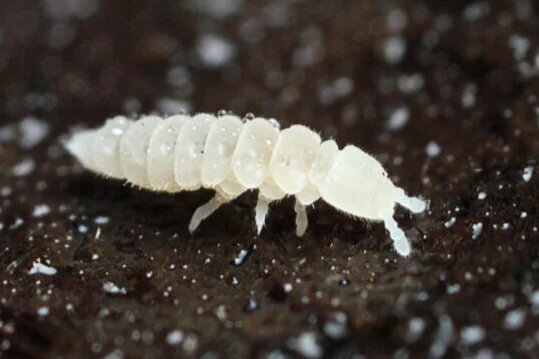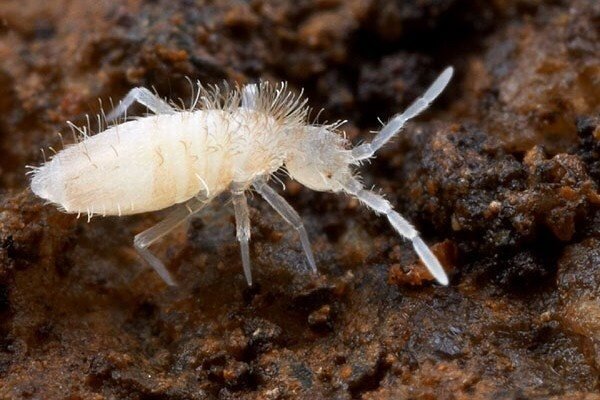Springtails in Terrariums: An Introductory Guide
Springtails in terrariums go hand in hand, and are widely known as an essential accessory to terrariums, especially when moss is involved. But what makes them so special and why are terrariums healthier with them?
Springtails and Natural Resources
Above photo:
Blind and non-existant furcula*, part of the Onychiuridae family.
Below photo:
Functioning eyes and furcula*, part of the Entomobryidae family.
*Furcula is the appendige responsible for jumping.
All things you apply to a terrarium will be subjected to high amounts of moisture and warmth leading to faster decay, especially right after the terrarium has been made. The reason for this is that at the beginning of the terrariums life, the materials inside are much more volatile from the sudden introduction of constant moisture and warmth which is the perfect location for decomposition to start, and for mould to thrive.
A springtails main food source is mould arising from decomposing matter. Just like all life, moulds goal is to reach fruiting stage and spread its spores. Springtails being present will actively keep mould from maturing and is an excellent way to stop manual intervention in a terrarium.
The reason manual intervention to stop mould is riskier is that you may be unknowingly spreading mould through opening the lid and rushing air in, or by disturbing clusters when attempting to remove the mould.
As mould takes in oxygen and releases carbondioxide, mould in large amounts will reduce the total oxygen in a terrarium and has the potential to increase temperature with increased CO2 amount. Oxygen levels lowering can also kill other terrarium life through asphyxiation.
Springtails in reduced oxygen and higher heat will reduce average springtail size as heat requires a higher metabolic rate and favours smaller life. Springtails can reduce their overall size by up to 30% if required by molting back to back but over a long period of time in a closed ecosystem, springtails will not be given the chance to get to such a size.
Springtails also eat fungus and have the potential to clean up root rot as root rot is not actually rotting of the root but a fungus growing around the root, suffocating the plant.
Feeding springtails by adding your own food inside your terrarium is not necessary and may only increase mould amounts and potentially ruin aesthetics and damage moss & plants.
Self Regulation & Life
Springtails are excellent at being in a terrarium due to their natural ability to self regulate their population. Springtail populations fluctuate to reflect the amount of food available. If your terrarium has high amounts of decaying materials, the abundance of food will ramp up their population. Alternatively, if your terrarium is healthy after establishment and there are low amounts of food available, the springtails with their short life span will not be able to feed themselves enough to multiply. As numbers start to drop off, the remaining springtails will consume the decomposing bodies, providing opportunity for the remaining springtails to continue their life.
Springtails require a moist environment to survive. If you are unable to see them in your terrarium, they may be burrowed under the surface in an attempt to reach moisture or are disturbed by a breeze. Springtails are usually used in a closed terrarium and work well as a part of a bio-active ecosystem, they can also work in an open terrarium providing there is enough moisture for them to want to stay. Springtails actively avoid roaming away from their enclosures even when open as they dehydrate quickly away from humidity.
Did you know?
Springtails are incredibly versatile and are said to have up to 100,000 species spanning the world from desert climate to snow and everywhere inbetween. This has given many springtails different characteristics and visuals.
Contrary to one of its most notable features and what it is named after, your springtail may be from the onychiuridae family and wont even have a furcula (the flipper allowing it to jump)! Some springtails are predatory and are known to eat nematodes and other invertebrates in your terrariums.
Springtails have been known to increase the spread of moss through something resembling pollination as they are attracted to pheromones coming from female mosses. Springtails aid the transfer of the male mosses sperm to the female egg. This is a very important factor in a terrarium as a terrarium has no means of sperm transfer and spore spread with no flowing water or air. Read up more about this here.
Springtails are the perfect bug to keep your bio-active terrarium safe and looking fresh.




